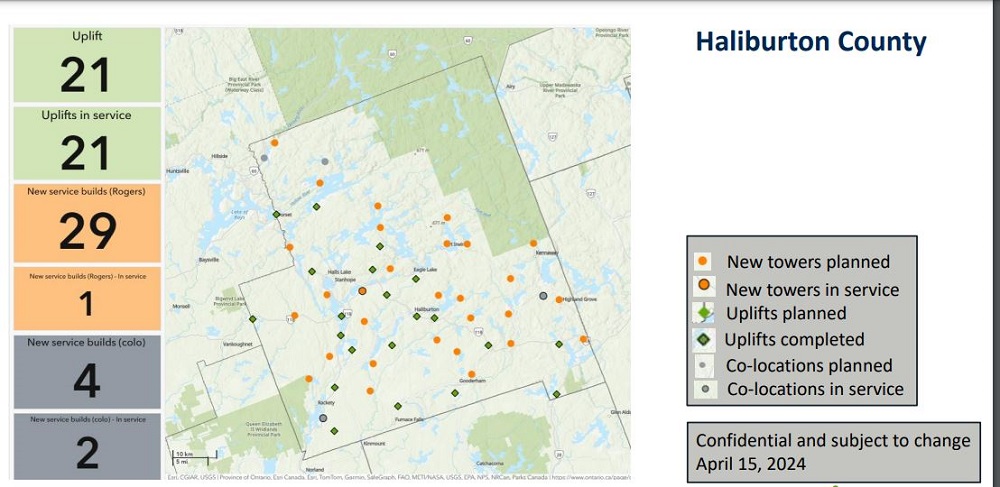It will still be two years before some Haliburton County residents, and visitors, can make and receive phone calls on major roadways, as well as do email, web browsing, social media, video conferencing, movie streaming, and other more data intensive applications.
The Eastern Ontario Regional Network’s (EORN) director of communications, Lisa Severson, updated County council May 8 on the cell gap project that began in 2021.
When complete, the plan aims for 99 per cent coverage in the region for calls; 95 per cent for email, web browsing and social media, and 85 per cent for more data-intensive applications. Partners, the federal and provincial governments, the Eastern Ontario Wardens Caucus, and Rogers, are investing more than $300 million, including about $31 million in Haliburton County.
Severson provided a concrete example of the project’s goals. She said she was in Belleville for a course recently and was not connected to their Wi-Fi network
“I went out to my car and I was able to do a Zoom meeting. It’ll enable things like that. Or, if you have your EMS folks, or your public works people out on the roads, they’ll be able to connect with the hospital in the event of an emergency.
Only one of 29 new towers online
They can livestream with the emergency room. So, that’s very important. It also means there’s more capacity in the network. So, it’s not just about coverage, but also the ability to grow that network.”
Severson said it takes a year to two years to complete a tower. They need to find a property, negotiate a lease, conduct archaeological and natural heritage assessments, follow a land use process with municipalities, then notify the province that a site is ready. After that, they have to do site preparation, order and receive supplies for construction, schedule crews to build the tower and submit layout plans for utilities, build the tower, hook up power to the site, and test the tower.
Severson added that EORN has a duty to consult with 18 indigenous communities and organizations.
“It took 13 months to satisfy the requirements of meaningful consultation to allow construction to start,” she said. She added they’d done archeological and natural heritage assessments on 178 new tower sites across Eastern Ontario.
For Haliburton County, the progress report is that 21 of 21 sites have been upgraded. However, new builds are lagging, with just one of a planned 29 new builds in service. They’ve done two of four co-locations.
Severson made reference to the fact there are still 11 land use authority or LUAs outstanding in the County, and, “we’re getting close to a point where if we don’t start moving on some of the towers and the LUAs, it’s going to put completing those towers in jeopardy.”
Coun. Bob Carter said the work is for cell phones, but asked about high-speed internet and broadband, “which is the second part of all of this.”
Severson said while it is a cell gap project, the equipment can do both. She said it will be up to Rogers as to if, and when, they roll out that service to customers. “They may not do it on every tower, but they are offering it in some areas with their broadband. We can try and find out more information about what that looks like for Haliburton County. I do know that there is a need for it here.”
Coun. Cec Ryall said there were complaints about public consultation with Rogers in the early stages of the cell gap project. “Do you know if that has been investigated and resolved, because it created unnecessary stress?”
Severson said when they hear of issues, they immediately report them to Rogers, “because everybody should be treated respectfully and you want to ensure that’s happening.”
Warden Liz Danielsen also asked Severson to publicly comment on why they are not looking at Crown land to site towers. She said it’s because they would need environmental assessments and it would make the timelines prohibitive.





